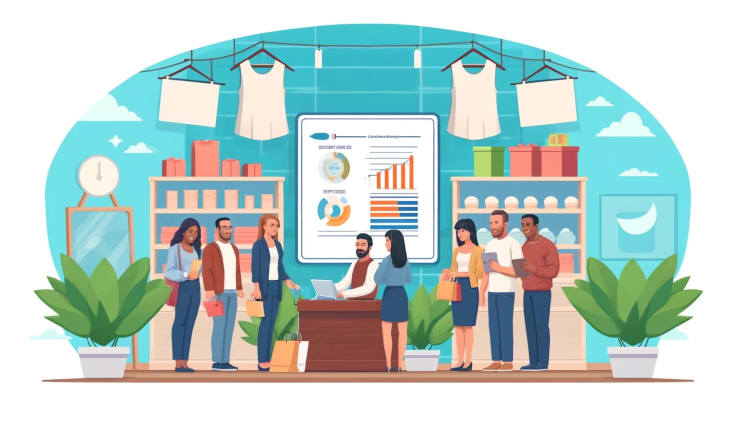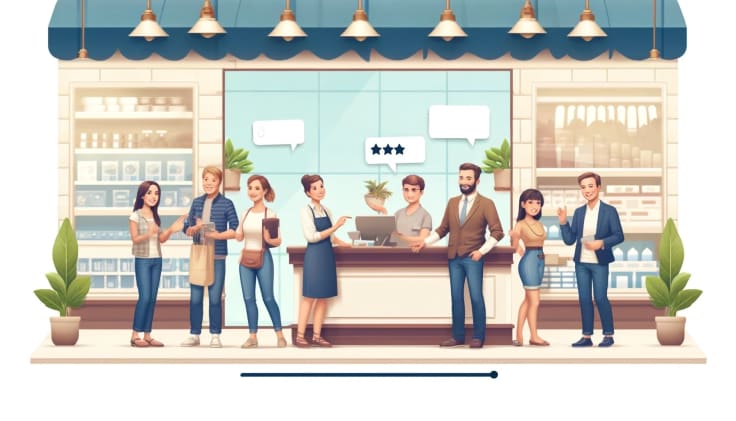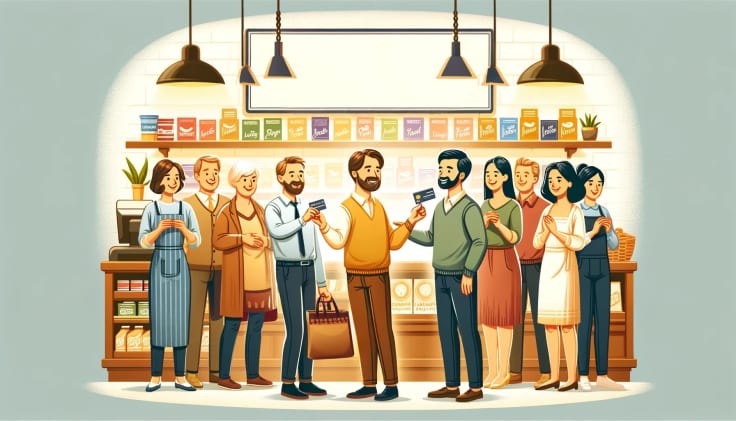Showing top 0 results 0 results found
Showing top 0 results 0 results found
Retaining customers can often feel like an uphill battle. Despite offering exceptional products or services, customers may vanish, leaving you wondering what went wrong. Promoting customer loyalty is a challenge that leaves many businesses scrambling for solutions.
However, understanding the dynamics of customer loyalty can transform your approach, converting occasional buyers into devoted advocates for your brand. Imagine turning casual shoppers into passionate brand advocates through loyalty programs, personalized marketing, and community building.
In this article, I’ll explore the principles of cultivating strong customer relations and offer practical strategies to enhance loyalty and foster long-term growth.
Here’s what I’ll cover:
- What customer loyalty really means.
- Why customer loyalty is your secret weapon for growth.
- The 3 Rs and 4 Cs of loyalty.
- Measuring loyalty and why it's not as hard as you think.
- Proven strategies to turn casual customers into loyal advocates.
- The psychology of loyalty.
Prepare to uncover the secrets of building a brand that not only attracts customers but also earns their enduring trust and commitment.
Customer loyalty definition
Customer loyalty refers to a customer's consistent preference for and commitment to a particular brand, product, or service. It manifests through repeated purchases, positive word-of-mouth recommendations, and a general willingness to choose your offerings over competitors, even when alternatives are available.
Loyalty isn't just about repeat purchases, though that's definitely a huge perk. It's about customers:
- Choosing you over competitors, even if someone else is cheaper or flashier.
- Actively recommending you to friends, family, and that random guy on the bus.
- Giving you the benefit of the doubt when things go wrong because they trust you to make it right.
- Feeling a genuine connection to your brand, like they're part of something bigger than just a transaction.
Customer loyalty is a two-way street. It's built on mutual respect, trust, and the delivery of consistent value. Your customers feel appreciated, understood, and even loved. In return, they reward you with more purchases and positive testimonials.
What is the difference between customer loyalty and customer satisfaction?
Customer loyalty and customer satisfaction, while closely related, represent distinct concepts within the realm of customer relationship management.
Customer satisfaction refers to the degree to which a customer's expectations and needs are met by a product or service. It's a measure of how happy customers are with what they receive. Satisfaction can be influenced by factors like product quality, customer service, price, and overall user experience.
Customer loyalty, on the other hand, goes beyond mere satisfaction. It encompasses a deeper emotional connection and commitment to a brand. Loyal customers consistently choose your brand over competitors, not just because they are satisfied with the products or services, but because they trust and feel an affinity towards your brand.
Loyalty often leads to repeat purchases, brand advocacy, and a strong resistance to switching to other brands, even in the face of competitive offers. While satisfaction can be a fleeting and situational response, loyalty is built over time through consistent positive experiences and a perceived alignment with the brand's values and identity.
Although customer satisfaction is a necessary foundation for building positive relationships, it is customer loyalty that drives long-term business success.
Why is customer loyalty important?
Loyal customers drive consistent revenue. They tend to make repeat purchases, providing a reliable income stream that can stabilize a business, especially in fluctuating markets. Unlike new customers, who might be trying a product or service for the first time, loyal customers have a proven track record of purchasing.
In fact, existing customers may generate even 65% of your sales! That’s because loyal customers typically have higher lifetime value. The total revenue a business can expect from them over time is greater compared to non-loyal customers. Compare that to the fact that it’s more expensive to acquire new customers than to retain the ones who already bought from you.
Speaking of money, loyal customers are also less sensitive to price changes. Their trust and satisfaction with your brand make them less willing to switch to competitors over minor price differences.
Loyal customers often become brand ambassadors, sharing their positive experiences with others through word-of-mouth. Recommendations from trusted sources are highly influential and can attract new customers more effectively than traditional advertising.
In addition, loyal customers provide valuable feedback. Their ongoing relationship with a brand means they are more likely to offer constructive criticism and improvement suggestions, helping businesses better meet customer needs. This feedback loop is essential for continuous innovation.
The 3 Rs: retention, relationships, and referrals
The 3 R's—retention, relationships, and referrals—are crucial components of a successful customer loyalty strategy. Together, they help businesses build a loyal customer base, foster strong connections with their audience, and expand their reach through word-of-mouth marketing.
Retention
Customer retention refers to a business's ability to keep its existing customers over time. High retention rates indicate that customers are satisfied with the products or services and have developed loyalty to the brand. Retention is important because it is generally more cost-effective to retain existing customers than to acquire new ones.
Effective retention strategies might include:
- Ensuring that products or services consistently meet or exceed customer expectations.
- Tailoring interactions and offerings to individual customer preferences.
- Providing prompt, helpful, and friendly support to resolve issues and enhance the customer experience.
- Rewarding customers for their continued business through points, discounts, or exclusive offers.
Relationships
Building strong customer relationships involves creating meaningful and lasting connections between the business and its customers. These relationships are based on trust, communication, and a deep understanding of customer needs and preferences. Strong relationships lead to increased customer loyalty and satisfaction.
Key elements of relationship-building include:
- Keeping customers informed through regular updates, personalized messages, and responsive interactions.
- Involving customers in the brand’s journey through social media, community events, or feedback opportunities.
- Providing additional value beyond the core product or service, such as helpful content, advice, or complementary services.
- Demonstrating genuine care for customers' needs and addressing their concerns with empathy and respect.
Referrals
Referral programs incentivize existing customers to recommend the business to new potential customers. This type of word-of-mouth marketing is powerful because people tend to trust recommendations from friends and family more than traditional advertising. Referral programs benefit both the referrer and the new customer, often through mutual rewards.
Components of a successful referral program include:
- Offering rewards such as discounts, free products, or cash bonuses to the referrer and the referred customer.
- Making the referral process simple and straightforward with easy-to-share referral links or codes.
- Clearly tracking referrals and communicating the status and rewards to participants.
- Actively promoting the referral program to ensure customers are aware and motivated to participate.
The 4 Cs: customization, communication, convenience, and cost
Customization, communication, convenience, and cost contribute to a successful customer experience strategy. Each of these components plays a critical role in meeting customer needs and enhancing satisfaction.
Here’s a detailed explanation of each:
Customization
Customization refers to tailoring products, services, and interactions to meet individual customers' specific preferences and needs. By offering personalized experiences, businesses can create a stronger connection with their customers, making them feel valued and understood.
Customization can be achieved through:
- Using data analytics and customer insights to suggest products or services that match individual preferences.
- Sending targeted messages and offers based on customer behavior and preferences.
- Allowing customers to personalize products according to their tastes and requirements.
- Adapting services to fit the unique needs of each customer, enhancing their overall experience.
Communication
Effective communication is the cornerstone of any successful customer relationship. It involves keeping customers informed, engaged, and satisfied through clear, timely, and relevant interactions.
Key aspects of communication include:
- Providing clear and honest information about products, services, policies, and changes.
- Listening to customer feedback and addressing their concerns and suggestions promptly.
- Offering various communication channels (email, social media, live chat, phone, etc.) to meet customers where they are most comfortable.
- Regularly updating customers on their order status, new products, and special promotions to keep them engaged and informed.
Convenience
Convenience is about making the customer journey as smooth and hassle-free as possible. Businesses can enhance the overall customer experience and increase satisfaction by reducing friction points and simplifying processes.
Key elements of convenience include:
- Designing user-friendly websites and apps that make it easy for customers to find what they need.
- Simplifying checkout processes, returns, and customer service interactions to save customers time and effort.
- Ensuring that products and services are easily accessible to all customers, including those with disabilities.
- Offering flexible delivery, payment, and support options to accommodate different customer needs and preferences.
Cost
Cost is a critical factor that influences purchasing decisions and customer loyalty. It’s not just about offering the lowest price but providing value for money. Customers need to feel that the benefits they receive justify the cost they pay.
Important aspects of cost include:
- Ensuring that prices are competitive within the market while maintaining quality and value.
- Providing clear and upfront pricing information without hidden fees or unexpected charges.
- Communicating the value and benefits of the product or service to justify the cost.
- Offering discounts, loyalty rewards, and special promotions to provide added value and savings to customers.
How to measure customer loyalty

Measuring customer loyalty involves evaluating various metrics and indicators that reflect the strength of the relationship between a business and its customers.
Here are several key methods and metrics to measure customer loyalty:
Repeat purchase rate
The repeat purchase rate (RPR) measures the percentage of customers who make multiple purchases over a given period. It indicates how often customers return to buy again.
Calculation:
RPR = (Number of Repeat Customers / Total Number of Customers) x 100
Customer lifetime value (CLV)
Customer lifetime value estimates the total revenue a business can expect from a single customer account throughout the business relationship. It helps in understanding the long-term value of loyal customers.
Calculation:
CLV = Average Purchase Value x Purchase Frequency x Customer Lifespan
Net promoter score (NPS)
NPS measures customer loyalty and satisfaction by asking customers how likely they are to recommend your business to others on a scale from 0 to 10. Customers are classified into three categories: Promoters (9-10), Passives (7-8), and Detractors (0-6).
Calculation:
NPS = %Promoters − %Detractors
Customer retention rate
The customer retention rate measures the percentage of customers a business retains over a specific period, indicating customer loyalty and satisfaction.
Calculation:
Retention Rate = (Number of Customers at End of Period − Number of New Customers Acquired During Period / Number of Customers at Start of Period) x 100
Customer churn rate
The customer churn rate is the opposite of retention rate and measures the percentage of customers who stop doing business with a company over a specific period.
Calculation:
Churn Rate = (Number of Customers Lost During Period / Number of Customers at Start of Period) x 100
Average order value (AOV)
AOV measures the average amount spent each time a customer makes a purchase. An increasing AOV can indicate higher loyalty, as customers may spend more per transaction over time.
Calculation:
AOV = Total Revenue / Number of Orders
Customer satisfaction (CSAT) Scores
CSAT surveys ask customers to rate their satisfaction with a product, service, or interaction on a scale (typically 1 to 5 or 1 to 10). High satisfaction scores correlate with customer loyalty.
Proven strategies to turn casual customers into loyal advocates

Ready to transform those one-and-done buyers into lifelong fans? Let's go through the nitty-gritty tactics for customer acquisition and build customer loyalty.
Wow them with exceptional service
This might seem like a no-brainer, but it's shocking how many businesses drop the ball on customer service. Go above and beyond to exceed expectations.
Empower your employees to solve problems on the spot, offer proactive support, and always follow up to ensure satisfaction.
Personalize your messaging
Nobody wants to feel like just another number. Use data to understand your customers' preferences and tailor your interactions accordingly.
Send personalized recommendations, birthday wishes, or even handwritten thank-you notes to make customers feel special.
Create a community
Build a space where your customers can connect with each other and your brand. Whether it's a Facebook group, a forum, or in-person events, foster a sense of belonging.
Encourage user-generated content, host contests, and offer exclusive perks to members of your community.
Reward loyalty
Everyone loves a good reward. Implement a customer loyalty program that offers tangible benefits like discounts, exclusive access, or early bird perks.
Make sure your loyalty program is easy to understand and rewarding enough to keep customers engaged.
Ask for feedback
Show your customers you value their opinions by actively seeking feedback. Then, use that feedback to improve your products, services, and overall customer experience.
Conduct surveys, monitor social media, and even reach out to customers directly for their input.
Surprise and delight
Go the extra mile to surprise your loyal customers with unexpected perks or gestures. It could be a free upgrade, a personalized gift, or a handwritten note.
Keep track of customer milestones like birthdays or anniversaries, and use those occasions to show your appreciation.
Be authentic
People can sniff out inauthenticity a mile away. Be genuine in your interactions, share your brand's story, and connect with your customers on a human level.
Share behind-the-scenes glimpses, spotlight your employees, and be transparent about your values and mission.
Deliver on your promises
Nothing erodes trust faster than broken promises. Make sure you deliver on what you promise, whether it's a product guarantee or a shipping timeline.
Underpromise and overdeliver. Set realistic expectations and then exceed them to create positive surprises.
Invest in employee training
Your employees are the face of your brand. Equip them with the skills and knowledge to deliver exceptional customer service and build strong relationships.
Offer regular customer service training sessions, encourage role-playing scenarios, and provide incentives for excellent support.
Stay ahead of the curve
Keep a finger on the pulse of your industry and anticipate your customers' changing needs. Stay ahead of the game by continuously innovating and improving your offerings.
Conduct regular market research, track industry trends, and seek customer feedback to identify growth opportunities.
Types of customer loyalty programs

A customer loyalty program should be designed to reward and retain customers by offering incentives that encourage repeat business and engagement.
You can choose a customer loyalty program from this list:
Points-based programs
This is one of the most popular types of loyalty programs. Customers earn points for each purchase, which can later be redeemed for rewards such as discounts, free products, or exclusive offers. The simplicity and clarity of accumulating points make this approach widely appreciated by customers.
Tiered programs
Tiered loyalty programs reward customers based on their level of engagement or spending. Customers who move up the tiers by spending more or engaging more frequently unlock increasingly valuable rewards and benefits. Tiered structure incentivizes higher spending and greater engagement, as customers aspire to reach the next level.
Paid membership programs
In these programs, customers pay a fee to join a membership club that offers exclusive benefits. Examples include free shipping, special discounts, or early access to new products. The upfront cost creates a sense of commitment, and the exclusive perks encourage ongoing loyalty.
Cashback programs
Cashback programs give customers a percentage of their purchase amount back in cash or store credit. This straightforward approach appeals to customers who prefer immediate financial rewards and can drive higher spending.
Punch card programs
Commonly used by small businesses like cafes and salons, punch card programs reward customers after a certain number of visits or purchases. For instance, a coffee shop might offer a free drink after every ten purchases. Punch card programs are simple and effective in encouraging repeat visits.
Gamified programs
Gamified loyalty programs incorporate game-like elements to make earning rewards fun and engaging. Customers might complete challenges, earn badges, or participate in contests to earn rewards. Gamification enhances customer engagement and creates a more interactive experience.
Referral programs
Referral programs reward customers for bringing in new customers. Existing customers receive incentives such as discounts or free products for each referral that makes a purchase. Brand advocacy and word-of-mouth marketing leveraged by this type of program can significantly expand your customer base.
Hybrid programs
Some businesses combine elements from different loyalty programs to create a hybrid approach. For instance, a program might offer points for purchases, including tiered benefits and gamified challenges. Hybrid programs can provide a more comprehensive and tailored loyalty experience.
Building a loyal customer base
Establishing a loyal customer base is not just an advantage; it's the cornerstone of sustainable business growth. By comprehending the intricacies of customer loyalty, accurately measuring it, and implementing effective strategies, you can transform your brand into an irresistible entity that customers are eager to support and remain loyal to.
Key takeaways:
- Customer loyalty is a long-term commitment built on trust, value, and mutual respect.
- Measure loyalty using both quantitative and qualitative metrics.
- Personalization, exceptional service, and community building are crucial for fostering loyalty.
- Loyalty programs with a variety of rewards and benefits incentivize repeat business.
Improve customer loyalty with LiveChat
Exceptional service is pivotal in cultivating customer loyalty. LiveChat is an invaluable tool for elevating your customer interactions. By engaging customers the moment they visit your website, you can guide them through their journey and build strong, lasting relationships in real time.
With LiveChat, you can:
- Instantly connect with customers through preset messages or personalized chats.
- Provide seamless support across multiple channels, including WhatsApp, Messenger, and Apple Messages.
- Boost sales by offering in-chat product recommendations.
- Streamline your workflow with AI-powered features like Chat Summary and Live Assistant.
- Gain valuable insights into customer behavior with easy-to-understand reports.
Ready to turn casual visitors into loyal brand advocates? LiveChat is the missing piece of your customer loyalty strategy. Try it today and watch your customer relationships—and your bottom line—thrive.








Comments